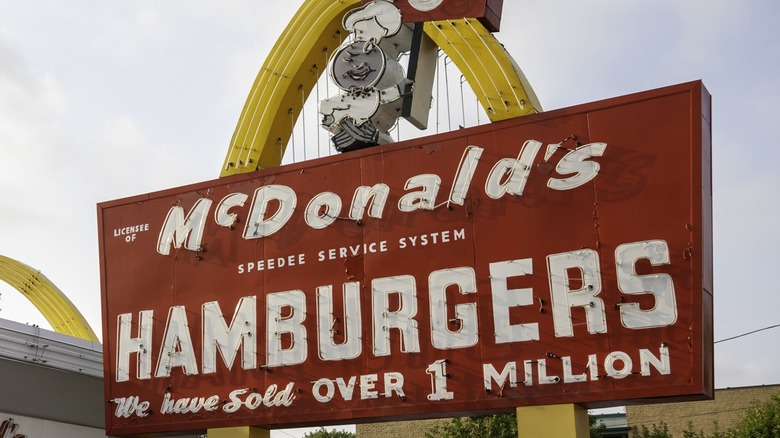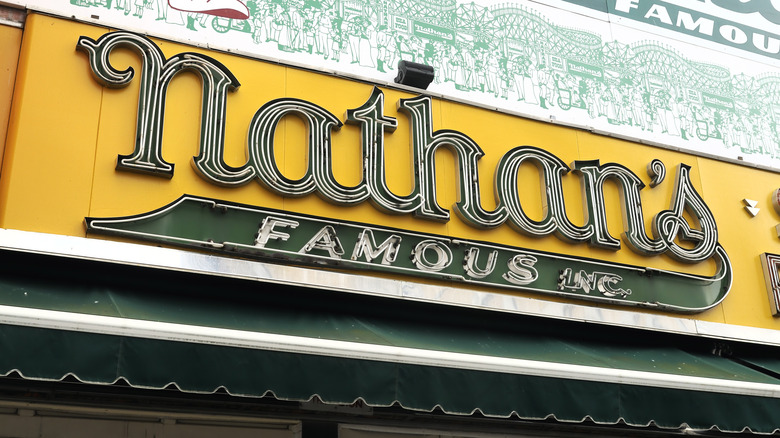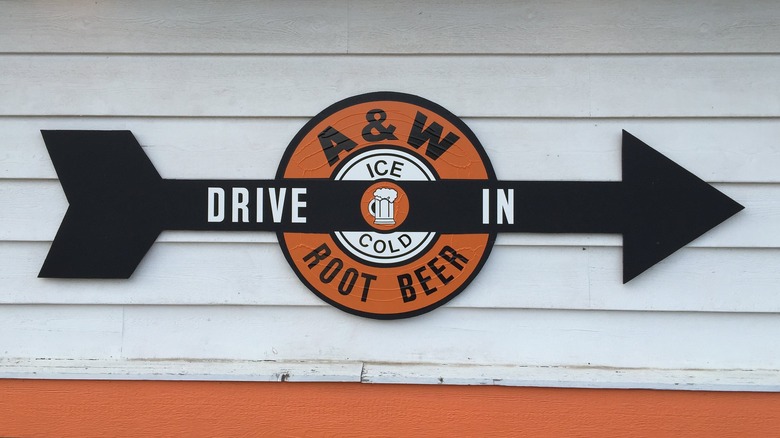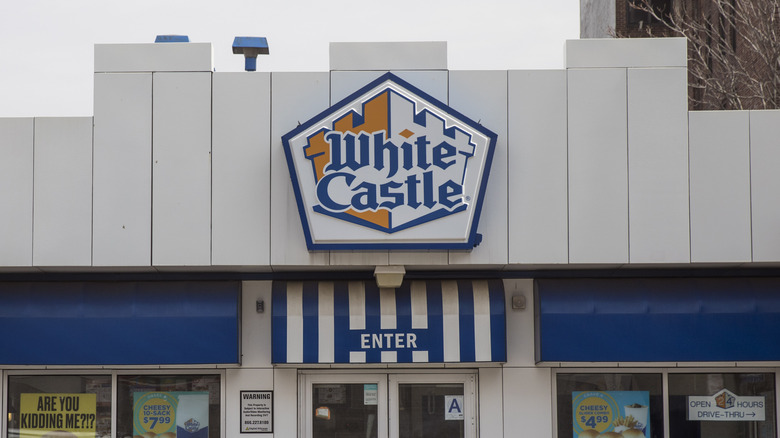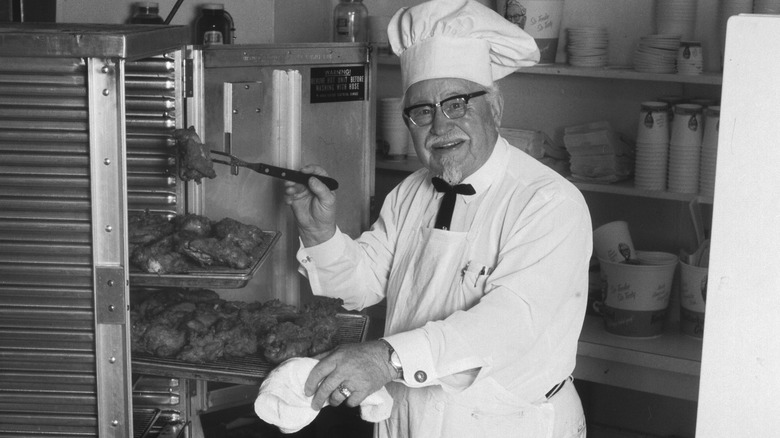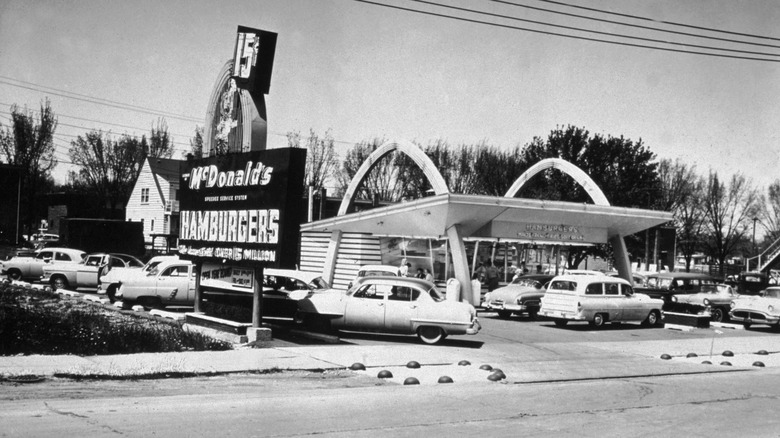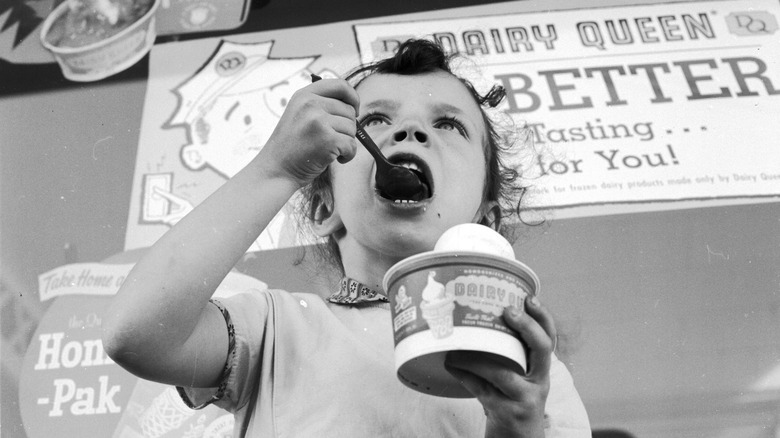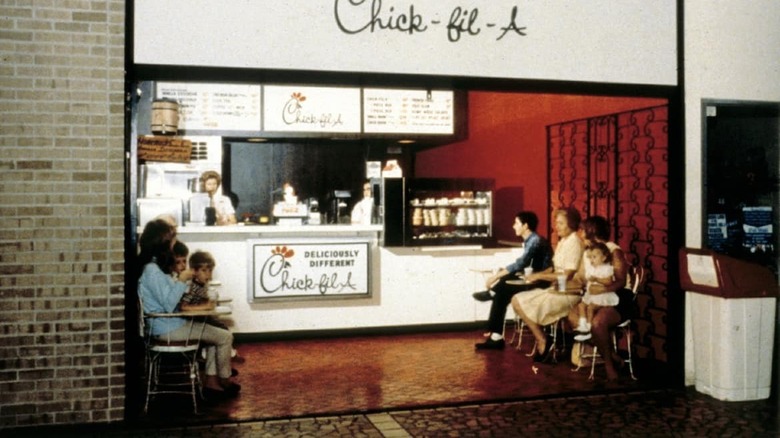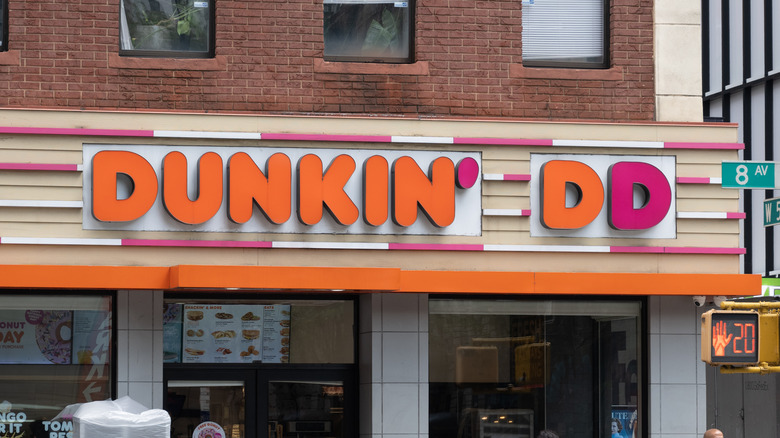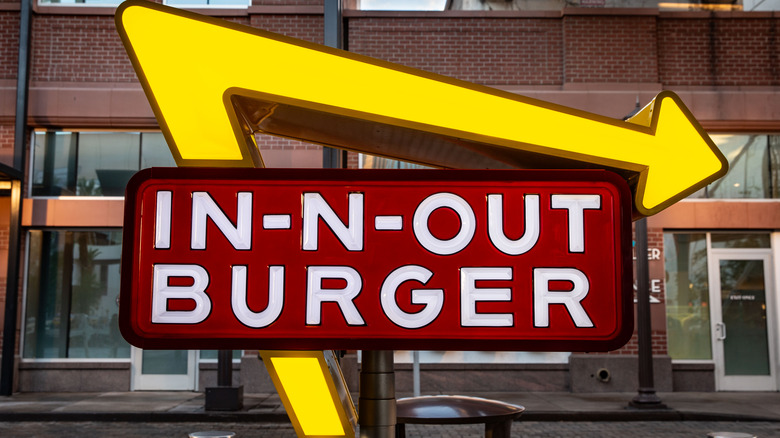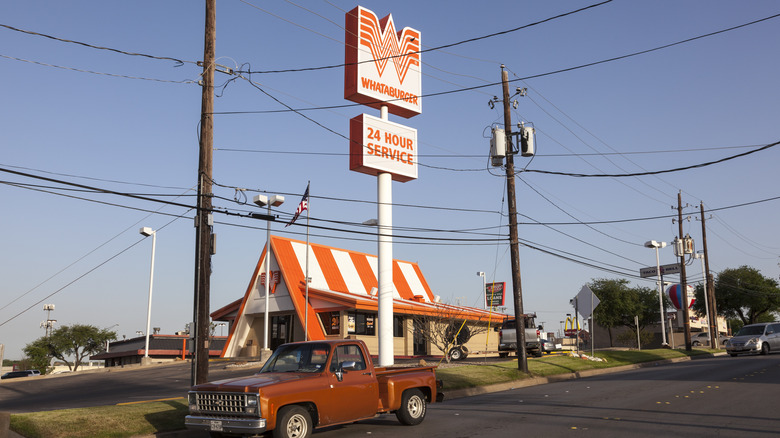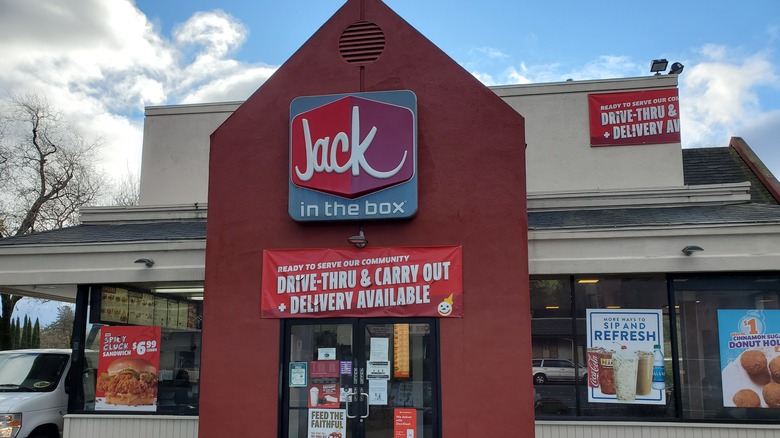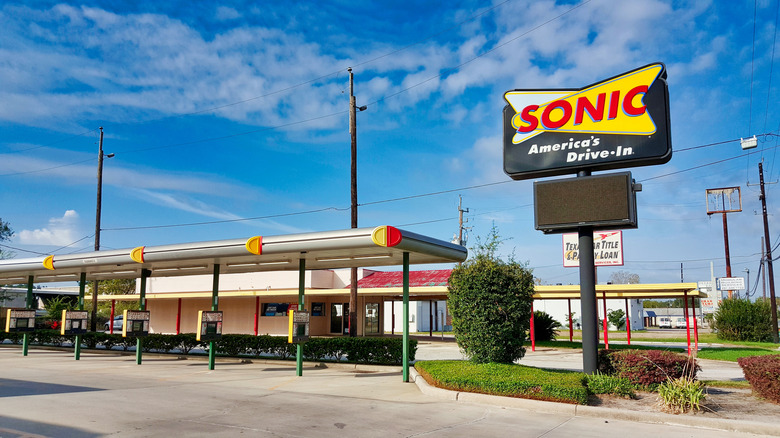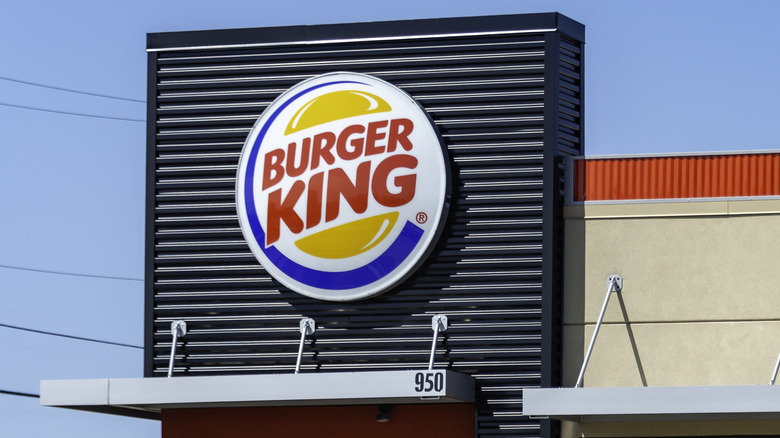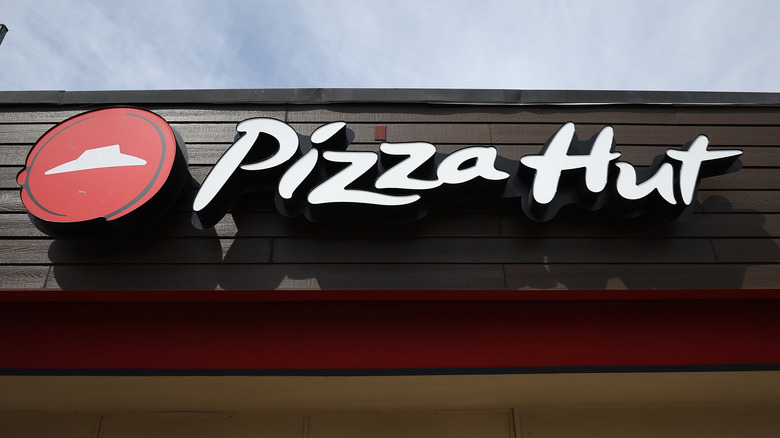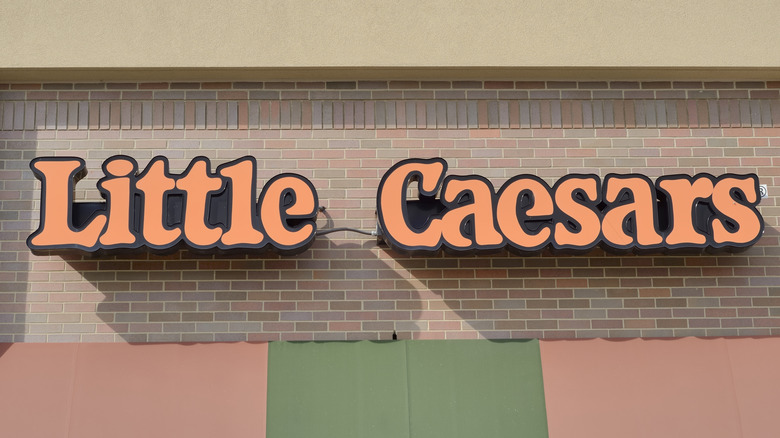The Oldest Fast Food Chains In The US
Though some of America's oldest fast food chains have been around for roughly a century, the real rise of fast food came after World War II. This was a time of innovation, when a postwar economic boom gave more families access to vehicles than ever before. A national promotion of car culture inspired a wave of novel fast food restaurants, an industry which revolved around automobiles with the introduction of drive-ins, carhops, and drive-thrus. This golden age of the U.S. economy catered to convenience and sparked a cultural moment during which most of today's best-known fast food chains came to be.
Today's longest-running fast food chains got their start in unassuming corners all across the country, and many of them have been around longer than you'd think. Here are some of the oldest fast food chains in the U.S., all of which were started before 1960, if not much earlier.
Nathan's Famous: 1916
Today, Nathan's Famous has locations across the country, but its origins lie in a long-standing New York City hot dog tradition. The concept of the hot dog in the United States originated with German immigrants who brought their frankfurter recipes with them to New York. Hot dog stands were not an uncommon sight, and one German immigrant in particular, Charles Feltman, found great success when he started serving hot dogs on Coney Island in Brooklyn. The beachside amusement park resort destination proved an optimal place for hot dog competition. Nathan Handwerker, a Polish immigrant, was one of Feltman's employees but eventually opened up a rival hot dog stand on Coney Island in 1916, which he called Nathan's Famous.
Though Nathan's wife's secret spice recipe for all-beef hot dogs surely spoke for itself, it was Nathan's marketing prowess that gained his stand great renown. His 5-cent hot dogs (half the price of his former employer's) initially aroused suspicion, with a lower price suggesting lower quality. But to garner a positive reputation, Nathan organized a hot dog-eating contest on the 4th of July during his first year of operations and also hired well-dressed people to eat his dogs in front of the stand, which successfully convinced passersby that Nathan's Famous must be famous for a reason. Since the 1950s, Nathan's Famous has been a chain, and the hot dog-eating contest at the original stand is an annual 4th of July tradition.
A&W: 1919
Though root beer dates back to pre-colonial times, A&W made it especially popular in the early 20th century. Roy Allen was in the right place at the right time when he opened a root beer stand on June 20, 1919, in Lodi, California. That night happened to be a homecoming celebration for World War I veterans, an occasion which called for something refreshing to drink. In 1922, Allen partnered with Frank Wright, thereby solidifying the business and its new name — "A" for Allen and "W" for Wright.
Allen and Wright spread their business by leasing their root beer stands to others so that they could open more stands, eventually making their way to the nearest major city, Sacramento. Quickly developing numerous locations under different ownership, A&W became America's first franchise chain. In 1923, A&W established California's first drive-in in Sacramento. Today, although numerous A&W establishments across the U.S. and Canada offer various items on their menus, the chain's continued emphasis on root beer makes it unique. The A&W taste may have something to do with the root beer its locations brew fresh from scratch every day.
White Castle: 1921
Another restaurant chain that first got famous serving meals for 5 cents, White Castle made its debut in Wichita, Kansas. Conceptualized by J. Walter Anderson, the business was inspired by his conviction that he could make better burgers than the diner where he once worked. As early as 1916, Anderson was operating a humble burger shack where he served small, square hamburgers. Though he didn't invent the hamburger, he made it into what we know and love today — a flattened beef patty cooked quickly and served between two halves of a bun.
Seeing promise in Anderson's burgers, entrepreneur Billy Ingram thought the burger stand had potential as a chain. The only problem was that the era was rife with public distrust in ground beef inspired by Upton Sinclair's 1906 novel, "The Jungle." Combatting this distrust was how White Castle got its name. The first White Castle opened in 1921, with the white decor meant to symbolize cleanliness and the "Castle" part of the name there to evoke a sense of permanence — the beef would always be clean. All the chain's kitchens had windows so there was no secret about how the burgers were made. Though today it may be overshadowed by other chains that have spread further, White Castle's resetting of America's perception of ground beef created the hamburger craze that paved the way for other names to feed a growing national craving.
KFC: 1930
Another chain with humble beginnings, KFC got its start in 1930 as a kitchen operating out of Harland Sanders' roadside filling station off U.S. Highway 25 in North Corbin, Kentucky. Feeding travelers with his special recipe for fried chicken, as well as mashed potatoes, biscuits, and gravy, Sanders found considerable success with a built-in clientele of highway commuters and regional tourists and gained enough local renown that Kentucky's governor granted him the ceremonial title of colonel in 1935.
Though the highway which provided Sanders' customer base was rerouted in the 1950s, leaving the fried chicken business bankrupt, Sanders' secret recipe spoke for itself when he met restaurateur Pete Harman, who was so convinced by Sanders' cooking he wanted to start serving it at his own restaurant. Harman and Sanders partnered, and under Harman's name of "Kentucky Fried Chicken," a chain was born. While today, we know a lot about what makes KFC's fried chicken so good, Colonel Sanders' original mix of 11 herbs and spices remains a closely guarded secret.
McDonald's: 1940
Maurice and Richard McDonald, two brothers from New Hampshire, wanted to make it out west and ended up with an open-air food stand in Monrovia, California. Situated near an airport also used as a shooting location for Hollywood films, the stand attracted a lot of customers looking for a quick and easy meal. Banking on continued success, the McDonald brothers opted to literally uproot their restaurant and place it in the center of a bigger town in the Los Angeles periphery. In 1940, they opened up their San Bernardino location, a drive-in with smartly dressed female carhops who would come out to take orders.
In 1948, the McDonald brothers revamped their business model, going for optimum speed and efficiency so that they could cut back on hiring costs and charge even lower prices. By condensing the menu, discouraging menu substitutions, and creating a self-service counter, they no longer required wait staff and could sell their food to customers almost instantly. The restaurant's success led to the beginning of a franchise, which caught the attention of milkshake machine distributor Ray Kroc in 1954. He expanded the McDonald's franchise and later bought out the McDonald brothers to turn the chain into the precise and unwavering ordering experience it is today. It has since become one of the most recognizable brands on the planet, and McDonald's continuously opens new stores at an astonishing rate.
Dairy Queen: 1940
Dairy Queen, known far and wide for its unparalleled soft serve ice cream, dates back to a recipe developed in 1938 by John Fremont and Bradley McCullough, whose family had been in the homemade ice cream business since 1927. Their soft serve was sold in Kanakee, Illinois, though the first Dairy Queen store got its start in Joliet, Illinois, in 1940 alongside the legendary Route 66.
Originally selling only ice cream-related treats, such as soft serve in cups, cones, and sundaes, the business expanded into franchises within the first decade of opening its doors. Dairy Queen's widely recognizable curl-topped cone became as legendary as its soft serve's creamy texture. Drive-thru DQs started popping up in the 1980, and in 1985, the Blizzard took the world by storm, with 75 million sold in its first year. Though Dairy Queen now sells hot and savory food as well, soft serve remains its claim to fame.
Chick-fil-A: 1946
Originating in a restaurant by a completely different name, Chick-fil-A's chicken was fried up as early as 1946, when founder Truett Cathy opened the Dwarf Grill in Hapeville, Georgia. Naming the restaurant for its small size, Cathy served burgers and other classic fare, but his business eventually became particularly known for its chicken sandwiches. Long since recognized as the inventor of the boneless chicken sandwich, Cathy worked continuously to improve his creation and perfected it with customer input over the course of 20 years. Switching tracks slightly, Cathy opened the first restaurant officially called Chick-fil-A in an Atlanta mall in 1967, and his chicken sandwiches, which had already become a local classic, gained even more notoriety.
Though the chain is highly selective about opening up new franchise locations, Chick-fil-A has gradually expanded nationally across 48 states, Washington D.C., and Puerto Rico, and has even grown internationally with locations in Canada.
Dunkin': 1948
Although World War II jump-started Dunkin' Donuts' introduction to the world, it was the timeless combo of coffee and donuts that brought the business its success. In the 1940s, a Quincy, Massachusetts, shipyard worker named William Rosenberg found that there was a market for lunch operations — workers didn't have many places to eat. With some borrowed money, he started an operation out of a truck, selling simple sandwiches and snacks, as well as coffee and donuts. The latter two were the most popular.
Prioritizing coffee and doughnuts, Rosenberg expanded operations, opening a restaurant which he called the Open Kettle in 1948. Selling just coffee and doughnuts proved to be immensely successful. While the business model didn't need much tweaking, Rosenberg decided in 1950 that the name did. Taking inspiration from his customers' habits of dunking their donuts in their coffee, he changed the restaurant to Dunkin' Donuts, and the name stuck. Five years after opening under a new name, Dunkin' Donuts launched its first franchise location. While Dunkin' has since expanded, with locations sprinkled throughout the States and in a few other countries, its restaurants remain most highly concentrated on the East Coast.
In-N-Out Burger: 1948
Another West Coast claim to fast food fame, the first In-N-Out burger opened for business in Baldwin Park, California, in 1948. Harry Snyder, the visionary behind the restaurant's inception, started small but dreamed big. The original operation was a 100-square-foot burger shack, but what made it special was Snyder's ingenuity. Taking dine-in versus drive-in out of the equation, Snyder devised a two-way intercom system that made it possible for customers to roll up, order, and keep on going, without ever having to leave their cars. Though the era was no stranger to drive-ins, In-N-Out was likely California's first drive-thru.
The business found success by sticking to a limited menu, and In-N-Out's menu has hardly changed since the beginning. But for those in the know, the Not So Secret Menu (which can be found on the restaurant's website) adds a bit of panache for those who want something more than the classic options. While the chain's reputation has gone worldwide, physical restaurant locations remain largely concentrated in the western U.S. but are gradually spreading eastward.
Whataburger: 1950
First opened in 1950 as an unassuming burger stand in Corpus Christi, Texas, Whataburger was Harmon Dobson's vision of a reimagined fast food experience. In an era where fast food competitors were cutting out personalized orders to maximize efficiency, Whataburger prioritized the individual. From the beginning, all burgers were made to order, a philosophy that persists to this day. Whether or not he was operating by the "everything's bigger in Texas" principle, Dobson was also intent on offering bigger burgers than anyone else. As the lore states, he wanted customers' first impressions of their meal to be "What a burger!" — hence the restaurant-turned-national chain's name.
It didn't take long for Whataburger's humble home base to expand. Within the first decade of business, Whataburger had become a chain, and in 1961, Dobson came up with the orange A-frame design recognizable today from miles away. Open 24 hours a day, Whataburger has a passionate fan base in its native state of Texas. Today, locations have spread to a number of states, though Whataburger is most accessible in the South and Southwest.
Jack in the Box: 1951
Jack in the Box started out with a name you'd never expect. Though the chain took off in the 1950s, the same owner and the same menu were operating in San Diego, California, under the name Topsy's Drive-In a whole decade earlier.
Robert Peterson was another milkshake mixer salesman who pivoted to enter into the mid-century fast food craze. Becoming a restaurateur with Topsy's in 1941, he reimagined his restaurant concept numerous times. After serving in the U.S. Navy during World War II, he rebranded Topsy's to become Oscar's. It was under this second reincarnation that the business finessed the art of the drive-thru. Peterson's restaurant chain had yet another facelift in 1951, when it was officially renamed Jack in the Box. Though today's drive-thru customers no longer order directly from a clown voiced by a hidden speaker, they have the benefit of ordering from a highly varied menu. While Jack in the Box locations have not yet reached the East Coast, they can be found just about anywhere else in the States.
Sonic: 1953
Troy Smith, who founded the drive-in that would go on to be Sonic, had been in the Oklahoma restaurant business since 1948. He ran several restaurants of various sizes in the town of Shawnee, and the surprising best-seller among them proved to be a simple drive-in root beer stand that was part of one of his other restaurants. Bringing this tangential stand into the limelight, Smith gave the drive-in an upgrade in 1953 and called it Top Hat.
Three years later, when entrepreneur Charlie Pappe stopped in at the Top Hat drive-in, he was so impressed he wanted to join the business. Pappe and Smith began a partnership that expanded the Top Hat restaurant to more locations but ran into the problem of the name "Top Hat" being copyrighted. The solution was simple — a swift name change to highlight the speed of their service. The restaurant became Sonic, and today, it is one of the few fast food chains that still proffers a true drive-in experience with carhop servers who greet customers directly at their vehicles.
With its origins as a root beer stand, Sonic's reputation today remains more with the drinks it offers than the accompanying food options. Sonic offers anywhere between 168,000 and 688,000 possible drink combos, depending on who's counting. The restaurant doesn't have quite so many locations, but Sonics can be found in most of America's 50 states.
Burger King: 1954
Whether Burger King's first restaurant was Keith Kramer and Matthew Burns' Insta-Burger King that opened up in Jacksonville, Florida, in 1953 or, as the chain itself states, James McLamore and David Edgerton's location which sprouted in Miami in 1954, the now-global franchise has its contested origins in 1950s Florida. Expanding quickly, Burger King garnered a reputation for its flame-grilled hamburgers.
First introducing the Whopper in 1957, Burger King has been inevitably and eternally in competition with its rival burger empire, McDonalds, which started up on the opposite coast. Burger King has often challenged McD's stalwart substitution-less menu with an open invitation for customers to order their meals the way they want them and is known for altering its menu with more innovative items just to see what happens. Burger King surprised many with its introduction of the plant-based Impossible Whopper in 2019, an indication that the chain remains open to innovation and eager to find what's next.
Pizza Hut: 1958
Italian immigrants introduced pizza to the U.S. in the late 19th century, but the concept didn't take off until after World War II, largely due to the American soldiers returning home who'd developed a taste for pizza pies while overseas. Though pizza generally wasn't quite as speedy as the burgers that had started a national trend for fast service and instant gratification, brothers Frank and Dan Carney in Wichita, Kansas, seized the era's rising pizza trend to turn it into a fast food phenomenon. The brothers decided on the name Pizza Hut because their original restaurant sign only had space to accommodate eight letters.
What started in 1958 as a small family-owned and operated pizza place just a hop and a skip from Wichita University quickly spread into a global chain that today has reached over 100 countries. Though the original restaurants revolved around a dine-in experience, Pizza Hut has evolved to become a predominantly take-out and delivery fast food service.
Little Caesars: 1959
Another chain that launched during the rising mid-20th-century pizza trend, Little Caesars was a hopeful business venture for Mike and Marian Ilitch. A few years into their marriage, the couple pooled their life savings to open a pizza place in Garden City, Michigan, near Detroit. A former minor-league baseball player, Mike had always had a fondness for pizza. When his first restaurant opened in 1959, it was initially called Pizza Treat, but Marian convinced Mike to change the name to something more interesting. "Little Caesar" was her nickname for him, inspired by his Macedonian heritage.
Though one of many pizza chains that opened up in the 1950s, Little Caesars established its own niche from the start by only serving pizza to go. Quickly expanding throughout Michigan during the first decade or so of operation, Little Caesars has since grown into an international franchise and has become the third-largest pizza chain in the world.
